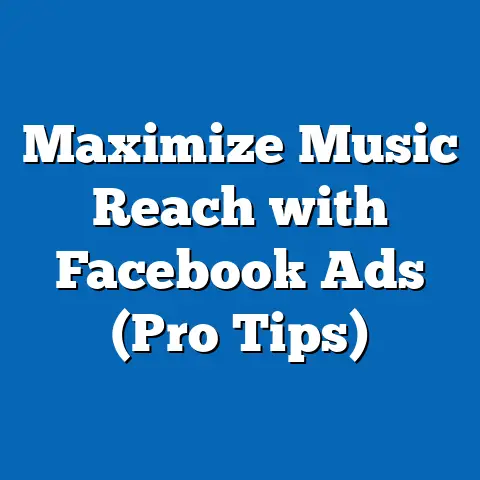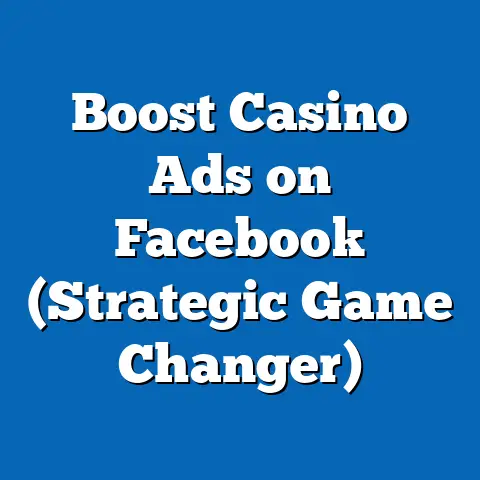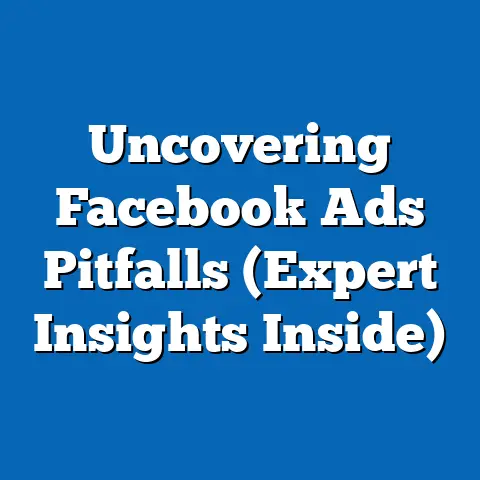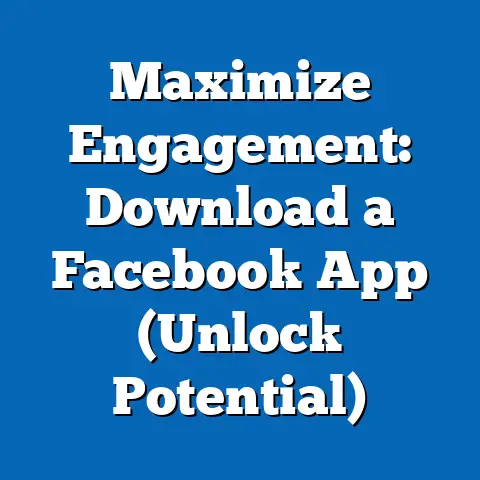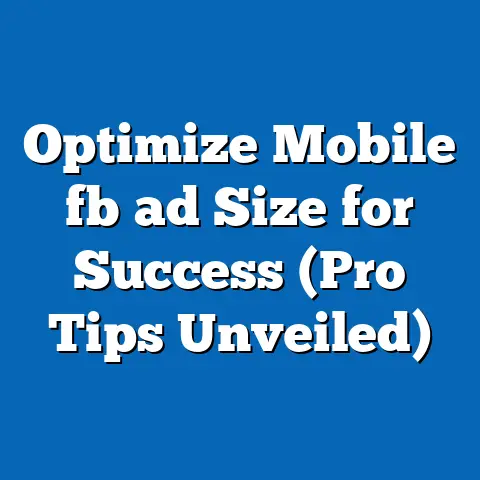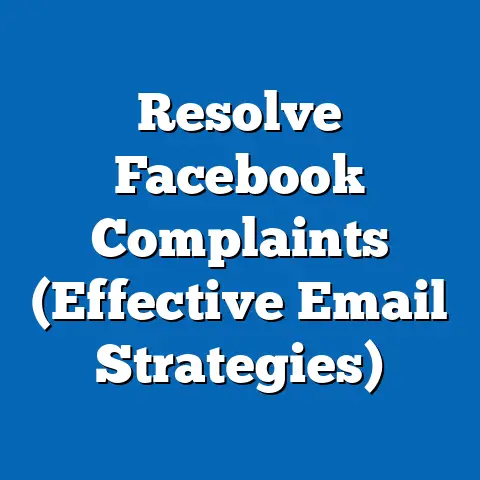Maximize Ad Performance with Facebook Lakes (Proven Strategies)
I remember when I first started dabbling in Facebook ads. It felt like throwing money into a black hole. Clicks were coming in, sure, but conversions? Forget about it. I spent countless hours tweaking targeting, fiddling with ad copy, and staring blankly at metrics that seemed to mock my efforts. I felt like I was missing something, a secret sauce that the big brands knew but kept hidden.
Then, I stumbled upon the concept of Facebook Lakes. At first, it sounded like more marketing jargon, another buzzword promising overnight success. But the more I dug in, the more I realized this wasn’t just a new feature – it was a fundamentally different way to approach Facebook advertising. It was about harnessing the power of data to create hyper-targeted campaigns that resonated with the right people at the right time.
The change wasn’t immediate, mind you. There was a learning curve, a period of experimentation, and a few more frustrating moments along the way. But once I started implementing the strategies I’m about to share with you, everything clicked. My click-through rates skyrocketed, my conversion costs plummeted, and my return on ad spend (ROAS) went through the roof.
Now, I’m not saying Facebook Lakes is a magic bullet. It’s not. It requires effort, dedication, and a willingness to learn. But if you’re tired of wasting money on ineffective Facebook ads and you’re ready to unlock the true potential of the platform, then keep reading. This guide will walk you through everything you need to know to maximize your ad performance with Facebook Lakes and achieve transformative results.
Understanding Facebook Lakes
So, what exactly are Facebook Lakes? Let’s break it down.
Essentially, Facebook Lakes are a way to leverage the vast amount of data that Facebook collects on its users to create highly targeted advertising campaigns. Think of it as a massive database of information, segmented into different “lakes” based on various demographics, interests, behaviors, and online activities.
This is a departure from traditional Facebook advertising, which often relies on broader targeting options and less granular data. With Facebook Lakes, you can dive deep into the data and identify niche audiences that are most likely to be interested in your products or services.
How Facebook Lakes Differ from Traditional Advertising
The key difference lies in the depth and precision of the targeting. Traditional Facebook advertising allows you to target users based on broad categories like age, gender, location, and general interests. Facebook Lakes, on the other hand, allows you to target users based on specific behaviors, purchase histories, and even their interactions with other brands and websites.
For example, instead of just targeting “fitness enthusiasts,” you can target “fitness enthusiasts who have purchased protein powder online in the last 30 days” or “fitness enthusiasts who follow specific fitness influencers on Instagram.” This level of granularity allows you to create highly personalized ad campaigns that resonate with your target audience and drive better results.
The Technology Behind the Magic
The power of Facebook Lakes comes from the sophisticated algorithms that Facebook uses to collect, analyze, and categorize user data. These algorithms track everything from the websites you visit and the pages you like to the products you purchase and the content you share.
This data is then used to create detailed user profiles, which are then segmented into different “lakes” based on various criteria. When you create a Facebook ad campaign using Facebook Lakes, you’re essentially tapping into these pre-segmented audiences and targeting users who are most likely to be interested in your offer.
The Importance of Audience Segmentation
Audience segmentation is the cornerstone of effective Facebook advertising. By dividing your target audience into smaller, more homogenous groups, you can create ad campaigns that are tailored to their specific needs and interests.
Facebook Lakes make audience segmentation easier and more effective by providing access to pre-segmented audiences based on a wide range of criteria. This allows you to create highly targeted ad campaigns that resonate with your target audience and drive better results.
Real-World Examples of Success
Let’s look at a few examples of businesses that have successfully utilized Facebook Lakes in their ad strategies:
- A local bakery: This bakery used Facebook Lakes to target users in their local area who had recently searched for “birthday cakes” or “cupcakes” online. They created an ad campaign that showcased their custom cake designs and offered a special discount for first-time customers. As a result, they saw a significant increase in cake orders and foot traffic to their bakery.
- An e-commerce store selling eco-friendly products: This store used Facebook Lakes to target users who had expressed an interest in sustainability, eco-friendly products, or environmental conservation. They created an ad campaign that highlighted the eco-friendly materials used in their products and emphasized their commitment to ethical sourcing. This resonated with their target audience, resulting in a significant increase in sales and brand awareness.
- A financial services company: This company used Facebook Lakes to target users who had recently visited their website or downloaded their free e-book on retirement planning. They created an ad campaign that offered a free consultation with a financial advisor and emphasized the importance of planning for the future. This resulted in a significant increase in leads and new clients.
Takeaway: Facebook Lakes offer a powerful way to leverage data and algorithms for precise ad targeting. By understanding the underlying technology and focusing on audience segmentation, you can create highly effective Facebook ad campaigns that drive real results. Next, we’ll dive into proven strategies you can implement right away.
Proven Strategies to Maximize Ad Performance with Facebook Lakes
Now that you understand what Facebook Lakes are and how they work, let’s dive into some proven strategies you can use to maximize your ad performance. These strategies cover everything from audience targeting and creative optimization to data-driven decision-making and budgeting techniques.
Audience Targeting and Segmentation
I can’t stress enough how crucial precise audience targeting is for Facebook ads. It’s like aiming a rifle versus a shotgun – with the right targeting, you’re far more likely to hit your mark.
The Importance of Precise Targeting
Think about it: why waste your ad spend showing your product to people who have zero interest in it? Precise targeting ensures your ads are seen by the individuals most likely to convert. This means higher click-through rates (CTR), lower cost-per-acquisition (CPA), and a better return on your investment.
Targeting Options within Facebook Lakes
Facebook Lakes offer a wealth of targeting options, allowing you to narrow down your audience based on a variety of factors:
- Demographic Targeting: Target users based on age, gender, location, education, job title, relationship status, and other demographic information.
- Interest-Based Targeting: Target users based on their interests, hobbies, and passions. Facebook gathers this information from the pages they like, the groups they join, and the content they share.
- Behavioral Targeting: Target users based on their online behavior, such as the websites they visit, the products they purchase, and the ads they click on.
- Custom Audiences: Create custom audiences by uploading your own customer data, such as email lists or phone numbers. This allows you to target your existing customers with specific offers or promotions.
- Lookalike Audiences: Create lookalike audiences based on your existing customer data. Facebook will identify users who share similar characteristics and behaviors with your customers, allowing you to expand your reach and target new potential customers.
Creating Custom and Lookalike Audiences: Actionable Strategies
Here are some actionable strategies for creating custom and lookalike audiences:
- Upload your customer list: This is the foundation of your custom audiences. Make sure your list is clean and up-to-date.
- Use website traffic data: Install the Facebook Pixel on your website to track user behavior and create custom audiences based on website visitors.
- Engage with your content: Create custom audiences based on users who have interacted with your Facebook page, such as liking your page, commenting on your posts, or watching your videos.
- Experiment with different seed audiences: When creating lookalike audiences, experiment with different seed audiences to see which ones perform best. For example, try creating a lookalike audience based on your top 10% of customers or your most engaged website visitors.
- Refine your lookalike audiences: Facebook allows you to refine your lookalike audiences based on factors like location and age. Use this to further narrow down your targeting and improve your results.
Takeaway: Master the art of audience targeting within Facebook Lakes. By leveraging the various targeting options and creating custom and lookalike audiences, you can ensure your ads are seen by the right people, maximizing your ad performance and ROI.
Creative Optimization
Even with the best targeting in the world, a poorly designed ad will fall flat. It’s like having a perfectly aimed rifle but using the wrong ammunition.
The Power of Compelling Creative
Creative content is the heart and soul of your Facebook ad campaigns. It’s what captures the attention of your target audience and persuades them to take action. A compelling ad copy, visually appealing images, and engaging videos can make all the difference in your ad performance.
Crafting Effective Ad Copy
- Know your audience: Understand their pain points, desires, and motivations. Speak directly to their needs and offer a solution to their problems.
- Use clear and concise language: Avoid jargon and technical terms. Get straight to the point and highlight the key benefits of your product or service.
- Include a strong call to action: Tell users exactly what you want them to do, whether it’s “Shop Now,” “Learn More,” or “Sign Up Today.”
- Use social proof: Include testimonials, reviews, or case studies to build trust and credibility.
- A/B test your ad copy: Experiment with different headlines, descriptions, and calls to action to see what resonates best with your target audience.
Creating Visually Appealing Images and Videos
- Use high-quality images and videos: Blurry or pixelated visuals will turn off your audience. Invest in professional photography or videography to create visually appealing content.
- Use eye-catching colors and designs: Use colors and designs that are consistent with your brand and that capture the attention of your target audience.
- Use relevant images and videos: Make sure your visuals are relevant to your product or service and that they accurately represent your brand.
- Use video to tell a story: Video is a powerful way to engage your audience and tell a compelling story about your brand.
- Optimize your visuals for mobile: Most Facebook users access the platform on their mobile devices. Make sure your visuals are optimized for mobile viewing.
A/B Testing for Creative Excellence
A/B testing is essential for optimizing your creative content. By testing different ad variations, you can identify what works best and improve your ad performance over time.
- Test different headlines: Experiment with different headlines to see which ones capture the most attention.
- Test different descriptions: Experiment with different descriptions to see which ones generate the most clicks.
- Test different calls to action: Experiment with different calls to action to see which ones drive the most conversions.
- Test different images and videos: Experiment with different visuals to see which ones resonate best with your target audience.
- Track your results: Use Facebook Ads Manager to track your results and identify which ad variations are performing best.
Takeaway: Don’t underestimate the power of creative optimization. By crafting compelling ad copy, creating visually appealing images and videos, and A/B testing your creative elements, you can significantly improve your Facebook ad performance.
Data-Driven Decision Making
Flying blind in Facebook advertising is a recipe for disaster. You need to understand your metrics and use them to guide your strategy.
The Importance of Analytics
Analytics are the compass that guides your Facebook ad campaigns. By tracking and analyzing key performance indicators (KPIs), you can gain valuable insights into your ad performance and make informed decisions about your ad spend, targeting, and creative adjustments.
Key Performance Indicators (KPIs) for Facebook Lakes
Here are some key performance indicators (KPIs) you should be tracking for your Facebook ad campaigns:
- Reach: The number of unique users who saw your ad.
- Impressions: The number of times your ad was displayed.
- Click-Through Rate (CTR): The percentage of users who clicked on your ad.
- Cost-Per-Click (CPC): The average cost you pay for each click on your ad.
- Cost-Per-Impression (CPM): The average cost you pay for 1,000 impressions of your ad.
- Conversion Rate: The percentage of users who completed a desired action, such as making a purchase or signing up for a newsletter.
- Cost-Per-Acquisition (CPA): The average cost you pay for each conversion.
- Return on Ad Spend (ROAS): The amount of revenue you generate for every dollar you spend on advertising.
Interpreting Your Metrics
Understanding what these metrics mean is crucial for making informed decisions.
- Low Reach and Impressions: This could indicate that your targeting is too narrow or that your budget is too low.
- Low Click-Through Rate (CTR): This could indicate that your ad copy or visuals are not compelling enough or that your targeting is not relevant enough.
- High Cost-Per-Click (CPC): This could indicate that your ad is not relevant enough or that your competition is driving up the cost of clicks.
- Low Conversion Rate: This could indicate that your landing page is not optimized for conversions or that your offer is not appealing enough.
- High Cost-Per-Acquisition (CPA): This could indicate that your ad spend is not efficient or that your targeting is not effective.
- Low Return on Ad Spend (ROAS): This could indicate that your ad campaigns are not profitable and that you need to make significant adjustments.
Data-Driven Strategies
Here are some data-driven strategies you can use to optimize your Facebook ad campaigns:
- Use A/B testing to optimize your ad copy and visuals.
- Adjust your targeting based on the performance of your different audiences.
- Increase your budget for campaigns that are performing well and decrease your budget for campaigns that are not.
- Pause or eliminate campaigns that are not generating a positive return on investment.
- Use Facebook Analytics to track user behavior on your website and identify areas for improvement.
Takeaway: Data is your friend. Embrace it, analyze it, and use it to make informed decisions about your Facebook ad campaigns. By tracking your KPIs, interpreting your metrics, and implementing data-driven strategies, you can significantly improve your ad performance and ROI.
Budgeting and Bidding Strategies
Even the most brilliant ad campaign can fail if it’s not properly funded. Effective budgeting and bidding strategies are essential for maximizing your ROI on Facebook ads.
Effective Budgeting Techniques
- Set a realistic budget: Determine how much you can afford to spend on Facebook ads without breaking the bank.
- Start small and scale up: Don’t invest all of your budget upfront. Start with a small budget and gradually increase it as you see positive results.
- Use daily budgets: Daily budgets allow you to control how much you spend each day and ensure that you don’t overspend.
- Use lifetime budgets: Lifetime budgets allow you to set a total budget for your campaign and ensure that you don’t exceed it.
- Monitor your budget closely: Keep a close eye on your budget and make adjustments as needed.
Bidding Strategies Explained
Facebook offers a variety of bidding strategies, each with its own advantages and disadvantages.
- Cost-Per-Click (CPC) Bidding: You pay each time someone clicks on your ad. This is a good option if you’re focused on driving traffic to your website.
- Cost-Per-Impression (CPM) Bidding: You pay for every 1,000 impressions of your ad. This is a good option if you’re focused on brand awareness.
- Cost-Per-Acquisition (CPA) Bidding: You pay for each conversion that results from your ad. This is a good option if you’re focused on driving sales or leads.
- Automated Bidding: Facebook automatically optimizes your bids to get the best possible results within your budget. This is a good option if you’re new to Facebook advertising or if you don’t have the time to manually manage your bids.
Allocating Your Budget for Optimal Results
- Allocate your budget based on the performance of your different campaigns.
- Allocate more budget to campaigns that are performing well and less budget to campaigns that are not.
- Allocate your budget based on the seasonality of your business.
- Allocate more budget during peak seasons and less budget during off-seasons.
- Allocate your budget based on your target audience.
- Allocate more budget to audiences that are more likely to convert.
Takeaway: Budgeting and bidding are not an afterthought. They are integral to your Facebook ad success. By using effective budgeting techniques, understanding the different bidding strategies, and allocating your budget wisely, you can maximize your ROI and achieve your advertising goals.
Overcoming Common Challenges
Even with the best strategies in place, you’re bound to encounter challenges along the way. Knowing how to address these challenges is crucial for long-term success with Facebook Lakes.
Common Pitfalls and Challenges
- Ad Fatigue: Your audience gets tired of seeing the same ads over and over again.
- Low Engagement Rates: Your ads are not generating enough clicks, likes, comments, or shares.
- High Competition: You’re competing with other businesses for the same target audience.
- Algorithm Changes: Facebook’s algorithm is constantly changing, which can impact your ad performance.
- Data Privacy Concerns: Users are becoming increasingly concerned about data privacy, which can impact your ability to target them effectively.
Solutions and Strategies
- Ad Fatigue:
- Refresh your ad creative regularly.
- Experiment with different ad formats.
- Rotate your ads frequently.
- Use dynamic creative optimization to automatically optimize your ad creative.
- Low Engagement Rates:
- Improve your ad copy and visuals.
- Target a more relevant audience.
- Run contests and giveaways to encourage engagement.
- Use interactive ad formats, such as polls and quizzes.
- High Competition:
- Differentiate your brand from the competition.
- Target a more niche audience.
- Use a more aggressive bidding strategy.
- Offer a unique value proposition.
- Algorithm Changes:
- Stay up-to-date on the latest algorithm changes.
- Adapt your ad strategies accordingly.
- Focus on creating high-quality content that resonates with your target audience.
- Diversify your advertising channels.
- Data Privacy Concerns:
- Be transparent about how you collect and use user data.
- Obtain user consent before collecting their data.
- Comply with all relevant data privacy regulations.
- Focus on targeting users based on their interests and behaviors, rather than their personal information.
- Refresh your ad creative regularly.
- Experiment with different ad formats.
- Rotate your ads frequently.
- Use dynamic creative optimization to automatically optimize your ad creative.
- Improve your ad copy and visuals.
- Target a more relevant audience.
- Run contests and giveaways to encourage engagement.
- Use interactive ad formats, such as polls and quizzes.
- Differentiate your brand from the competition.
- Target a more niche audience.
- Use a more aggressive bidding strategy.
- Offer a unique value proposition.
- Stay up-to-date on the latest algorithm changes.
- Adapt your ad strategies accordingly.
- Focus on creating high-quality content that resonates with your target audience.
- Diversify your advertising channels.
- Be transparent about how you collect and use user data.
- Obtain user consent before collecting their data.
- Comply with all relevant data privacy regulations.
- Focus on targeting users based on their interests and behaviors, rather than their personal information.
Turning Challenges into Success Stories
I’ve seen businesses face these challenges head-on and come out stronger. For instance, a local clothing boutique was struggling with ad fatigue. Their solution? They started running weekly contests and giveaways, offering discounts and free products to their followers. This not only increased engagement but also generated a buzz around their brand and attracted new customers.
Another example is a tech startup that was facing high competition in their industry. They decided to focus on a more niche audience and offer a unique value proposition that differentiated them from the competition. They created a product that was specifically designed for small businesses and offered a free trial to new customers. This allowed them to attract a loyal customer base and build a strong brand reputation.
Takeaway: Challenges are inevitable, but they don’t have to derail your Facebook advertising efforts. By understanding the common pitfalls and implementing effective solutions, you can overcome these challenges and achieve your advertising goals.
Conclusion
Facebook Lakes offer a transformative approach to advertising, enabling businesses to tap into the platform’s vast data resources for unparalleled audience targeting and ad performance. Throughout this guide, I’ve shared proven strategies to maximize your ad campaigns, from precise audience segmentation and compelling creative optimization to data-driven decision-making and effective budgeting techniques.
Remember, success with Facebook Lakes requires dedication, experimentation, and a willingness to adapt. By implementing the strategies outlined in this article and continuously monitoring your results, you can unlock the true potential of Facebook advertising and achieve remarkable results for your business.
Don’t be afraid to start small, test different approaches, and learn from your mistakes. The key is to stay focused on your goals, remain adaptable to changes, and never stop striving to improve your ad performance.
With the right approach and tools, you too can achieve remarkable results in your Facebook advertising efforts.
Call to Action
Now that you have a solid understanding of how to maximize ad performance with Facebook Lakes, I encourage you to take action and start implementing these strategies in your own campaigns.
Share your experiences with Facebook Lakes in the comments below. What strategies have worked best for you? What challenges have you faced?
Follow my page for more insights and updates on maximizing ad performance. I’ll be sharing more tips, tricks, and best practices on Facebook advertising in the coming weeks.
Let’s work together to unlock the true potential of Facebook Lakes and achieve transformative results for our businesses!

